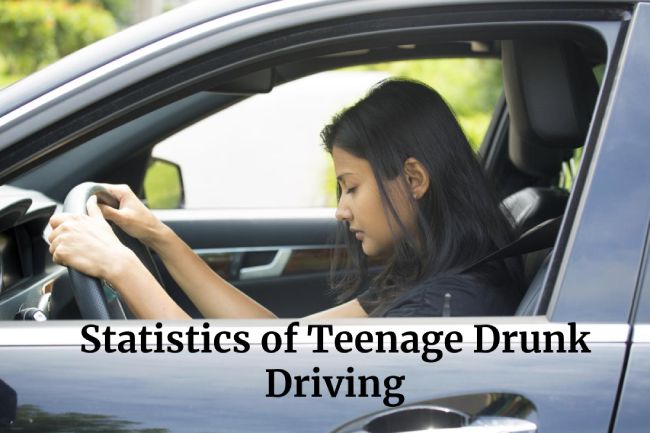There are many statistics regarding teenage drunk driving, and they are both frightening and preventable. Find out why teenagers drink, how that leads to them getting behind the wheel and the potential deaths that could result.
Why Do Teens Drink and Drive?
Alcohol is suspected to be a factor in 37% of teenage deaths in car accidents. Teens aged 16-19 are most likely to die in motor vehicle crashes, according to the CDC. The situation is further exacerbated by the fact that 70 percent of teens are still drinking alcohol. Exactly why? Teenagers drink for a variety of reasons, including:
Stressing Out
Alcohol use is twice as likely to occur among teens who are stressed out, according to the National Center on Addiction and Substance Abuse. Additionally, they use alcohol sooner if they are stressed. According to the study, they are starting to drink as early as 12 years old.
Everyone Is Doing It
Another leading cause of teen drinking is peer pressure. Due to peer pressure, teens may even think risk-taking behavior is expected of them, which contributes to risk-taking behaviors. At a party, teens want to fit in and be like everyone else, so they drink more.
Social Media
Teens who observe their friends drinking on social media are more likely to try it themselves, according to a study published in Alcoholism: Clinical and Experimental Research. Through pictures on Instagram or Snapchat stories, teens are likely to try risky behavior when they see their friends doing it.
Availability
Teenagers can drink alcohol even though the drinking age is 21. Alcohol is easier to obtain for girls than boys, but both age groups can get their hands on it fairly early. Alcohol is often given to children by their parents without their knowledge. About two out of three times, this happens.
Curiosity and Teens
Children tend to behave in some ways due to their curiosity and lack of impulse control. Teenagers’ brains are still developing. In contrast to adults, children need guidance to guide their curiosity in the right direction. It can lead to destructive behaviors such as drinking if it is not addressed.
Misinformation
Teenagers may believe that underage drinking is okay due to mass media and misinformation. Moreover, allowing teens to have a drink or two with their parents or just a sip could make them think they can handle alcohol.
As a result of their lack of brain development and altered state, they are more likely to engage in risky behaviors, like driving while intoxicated.

Teenage Drunk Driving Statistics
There are three general categories of teenage drunk driving statistics. Teen drinking and driving patterns can be revealed by exploring these categories in depth.
Risk Factors
Find out how teen driving habits and gender can contribute to drinking and driving. Here are some statistics to consider:
- Motor vehicle accidents are more likely to occur among teens than among older drivers, according to the CDC. A teenager who drinks and drives is more likely to get into an accident than one whose parents drink and drive. A teenager with a blood alcohol concentration of .08 is 17 times more likely to suffer an accident than one who does not drink, according to CDC Vital Signs.
- CDC statistics indicate that 58% of drunk drivers who died in a crash did not wear their seatbelts.
- Thirty percent of teens admitted to riding with a drunk driver within the past year, according to a study.
- According to the CDC Fact Sheet, teens consume more than 90% of their alcohol through binge drinking.
- Compared to women, men are twice as likely to be involved in a car crash and consume more alcohol.
Teens Drunk Behind the Wheel
Teenagers who get behind the wheel of a car while drunk are dangerous. To understand how dangerous it is, look at the statistics.
- Risky situations and hazardous circumstances are more likely to be encountered by teens.
- Teens are more likely to speed and narrow the distance between their vehicle and the car in front of them, according to a CDC study. There is no doubt that drinking would exacerbate this problem.
- According to CDC Vital Signs, teens drink and drive 2.4 million times a month.
Drunk Driving Deaths
Teenagers who get behind the wheel while drunk can and do die. Take a closer look at this deadly decision’s statistics.
- The majority of motor vehicle accident deaths occur between 3:00 p.m. and midnight. A further 53% occur on a Friday, Saturday, or Sunday, according to the CDC.
- A CDC Vital Signs study found that 1 in 5 teens who died in accidents had some alcohol in their systems.
- Alcohol-related incidents resulted in more than 118,000 emergency room visits by teens (CDC Fact Sheet).
Teens Who Are Drunk Should Not Drive
Having a drunk and driving is not a good idea for a teen. Rather than getting behind the wheel, there are always other things to do. Do not let peer pressure or other influences affect your decision not to drink and drive.
Being a teen involves making mistakes and growing up, but drunk driving is a mistake you may have to live with for the rest of your life.
